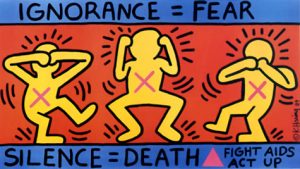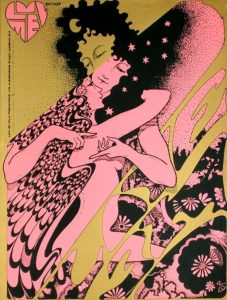Postmodernism essentially contradicts and challenges all aspects of modernism. The artwork created by postmodern artists opposes the “modernism’s utopian visions, which had been based on clarity and simplicity.”

Keith Haring’s ignorance=fear was created to promote awareness of AIDS,
for the activist group, AIDS Coalition to Unleash Power. The three figures represent “see,hear and speak no evil” to show how people refused to acknowledge those who suffered with AIDS.
The use of bold shapes and primary colours creates a visually interesting style of pop art that is prominent to Haring’s work that makes everything very simple, due to the fact you’re not distracted by anything within the piece. The bodies created by simple shapes,clearly show what the figures are doing. This makes you question what the campaign is about because you assume due to its simplicity its aimed at children, when the actual reason promotes a very serious topic, that was coming out as a near epidemic for the time period.
 Basquiat’s “King Alphonso” really interested me, once again, because of it’s limited colourscheme. The use of purely primary colours mixed with child-like fluidity to the drawings really drew me in. I found it interesting how Basquiat used colour only in the centre of the piece of work, which your eye is after you see the huge signature crown in which has become essentially a signature for Basquiat, which is seen as a sign for greatness, ‘Even if no one else sees it, he’s a king in his own right.’
Basquiat’s “King Alphonso” really interested me, once again, because of it’s limited colourscheme. The use of purely primary colours mixed with child-like fluidity to the drawings really drew me in. I found it interesting how Basquiat used colour only in the centre of the piece of work, which your eye is after you see the huge signature crown in which has become essentially a signature for Basquiat, which is seen as a sign for greatness, ‘Even if no one else sees it, he’s a king in his own right.’
I like how the disorderly scribbles in which produce a mind map that sit underneath the crown, they sort of connote how Basquiat knows post-modernism is going to be a
crucial movement within art.
 Jamal Shabazz’s Back to the World beautifully documents the subway in quite a contradictory way. Though what is being photographed isn’t seen to be beautiful, the way in which Shabazz captures those going about their daily life in an rough area, “It’s an interesting mashup of the elegance of humanity in spite of the decay of the city and those photographs had a warm, yellowy, upbeat quality to them.”
Jamal Shabazz’s Back to the World beautifully documents the subway in quite a contradictory way. Though what is being photographed isn’t seen to be beautiful, the way in which Shabazz captures those going about their daily life in an rough area, “It’s an interesting mashup of the elegance of humanity in spite of the decay of the city and those photographs had a warm, yellowy, upbeat quality to them.”
Jamel Shabazz,back to the world,1980
http://www.jamelshabazz.com -Young, B
http://www.vam.ac.uk/content/articles/p/postmodernism/
Keith Haring, Ignorance=Fear, 1989
Basquiat King Alphonso,1983
http://aloversanthology.com/king-alphonso/




 Rebellion was a crucial key to the counterculture movement, “summarised in (embracing) an alternative lifestyle characterized by…, brightly colored clothes, communal living, free sex, and rampant drug use”. The art created represented this hedonistic yet antipathy towards politics
Rebellion was a crucial key to the counterculture movement, “summarised in (embracing) an alternative lifestyle characterized by…, brightly colored clothes, communal living, free sex, and rampant drug use”. The art created represented this hedonistic yet antipathy towards politics 


